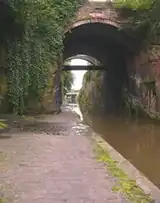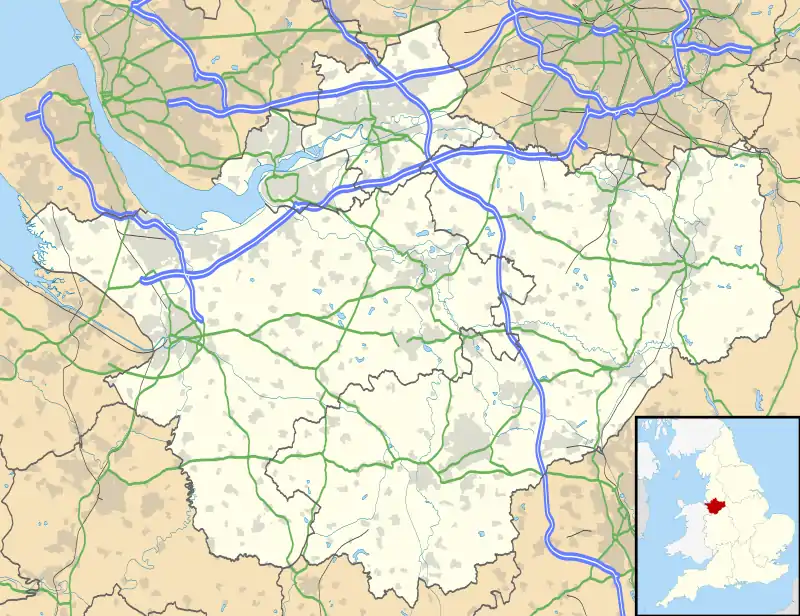Newtown, Chester
Newtown is an area of Chester, in the unitary authority of Cheshire West and Chester and the ceremonial county of Cheshire, England.
| Newtown | |
|---|---|
 | |
 Newtown Location within Cheshire | |
| OS grid reference | SJ408826 |
| Unitary authority | |
| Ceremonial county | |
| Region | |
| Country | England |
| Sovereign state | United Kingdom |
| Post town | CHESTER |
| Postcode district | CH1 |
| Dialling code | 01244 |
| Police | Cheshire |
| Fire | Cheshire |
| Ambulance | North West |
| UK Parliament | |
History

Newtown is an area of north-east Chester, just outside the city walls and to the east of Chester Cathedral and the Phoenix Tower. The main layout of streets originated in the late 1790s because of the location by the cattle market and along the Shropshire Union Canal.
Newtown, together with Boughton and Hoole, provided most of the workers to Chester during the Industrial Revolution of the late 18th century, leading to substantial wealth for the city.
Newtown's growth and importance to the Chester economy was driven from about 1793 by its location in the canal network, and from the 1840s by its location in the railway network, close to the two Chester railway stations: Chester General and Chester Northgate. The area supported a thriving community of artisans and working-class families who lived mainly in "two-up-two-down" terraced housing with no bathroom and an outside toilet. The last canal-side flour mill closed in the late 1950s.[1]
Because of its location in the canal and railway networks, Newtown in Chester, along with Liverpool and Manchester, became a hub of northern English commerce. The canal was the 'motorway' of its day and narrowboats carried produce and supplies to and from North Wales (coal, slate, gypsum and lead ore). Finished lead (for roofing, water pipes and sewerage), produced in the huge leadworks in Egerton Street Newtown, was exported all over the country. Grain from the Cheshire farmlands was processed in the large mills and granaries on the banks of the canal at Newtown and Boughton; and salt (for preserving food such as fish and meat) came from Northwich.
Present day

The two large estates, run by Chester & District Housing Trust, referred to as 'The Saints' Area' and 'Francis Street Flats', are a mixture of sheltered accommodation and normal family occupancy.[2] The 'saints' area has three large 1960s-built tower blocks (St Annes, St Oswalds and St Georges), along with many low-rise houses and maisonettes. On the opposite side of Hoole Way there are a further three tower blocks, namely, Heygarth Heights, Thackery Towers and Rowlands Heights, all built in the 1970s. These properties were built on an area which used to contain the old 'back-to-back' terraced houses; housing workers from the two railway stations, the Royal Mail depot and the old Chester Cattle Market.
Hoole Way virtually dissects the 'old' Newtown in half, and runs almost exactly along the route of what was Back Brook Street. There are still some surviving buildings which used to form part of the bottom end of the street (the top end being the Cattle Market end) - notably, number 24 Back Brook Street. In addition, the backs of the old vegetable and butchers shops can still be seen.

Brook Street is a local shopping area with a Post Office, shops, pubs and restaurants. The street used to be the main route into Chester from the north, leading to the railway station and Francis Street, another area of Newtown. Francis Street has three further 1970's-built high-rise tower blocks and more Chester & District Housing Trust social housing along with private housing. The Newtown area also contains a small 'arts' cinema.
Governance

Newtown forms part of an unparished area within the city of Chester. Administratively, the area is part of the unitary authority of Cheshire West and Chester in the ceremonial county of Cheshire. Cheshire West and Chester came into force in April 2009, when the Local Government and Public Involvement in Health Act was enacted,[3] and replaced the boroughs of Ellesmere Port and Neston, Vale Royal and Chester District. The equivalent unitary authority in the other half of the county is called Cheshire East. The decision to create the Cheshire West and Chester unitary authority was announced on 25 July 2007 following a consultation period, in which a proposal to create a single Cheshire unitary authority was rejected.[4]
The area is within the City of Chester parliamentary constituency.
References
- "Newtonsaints website". Archived from the original on 5 March 2012. Retrieved 17 April 2010.
- Chester Housing
- "Local Government and Public Involvement in Health Bill". Retrieved 9 August 2007.
- "County split into two authorities". BBC News. 25 July 2007. Retrieved 25 July 2007.